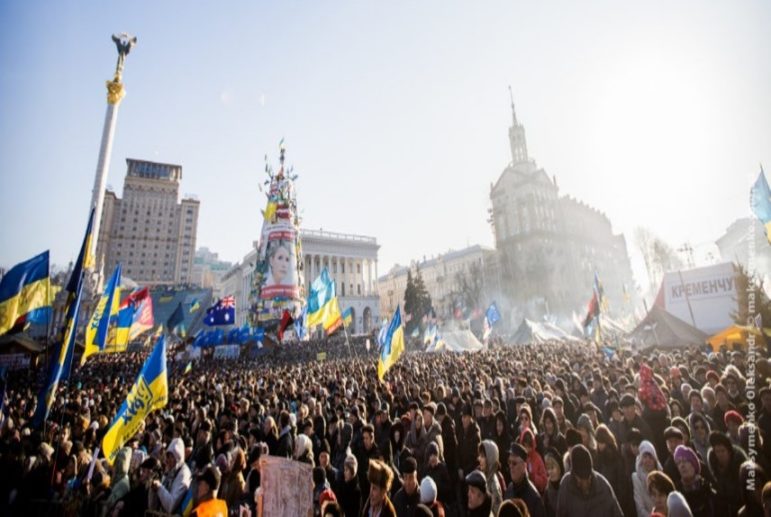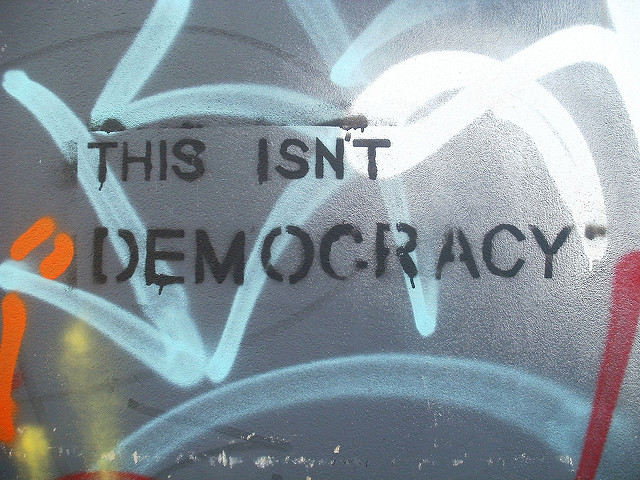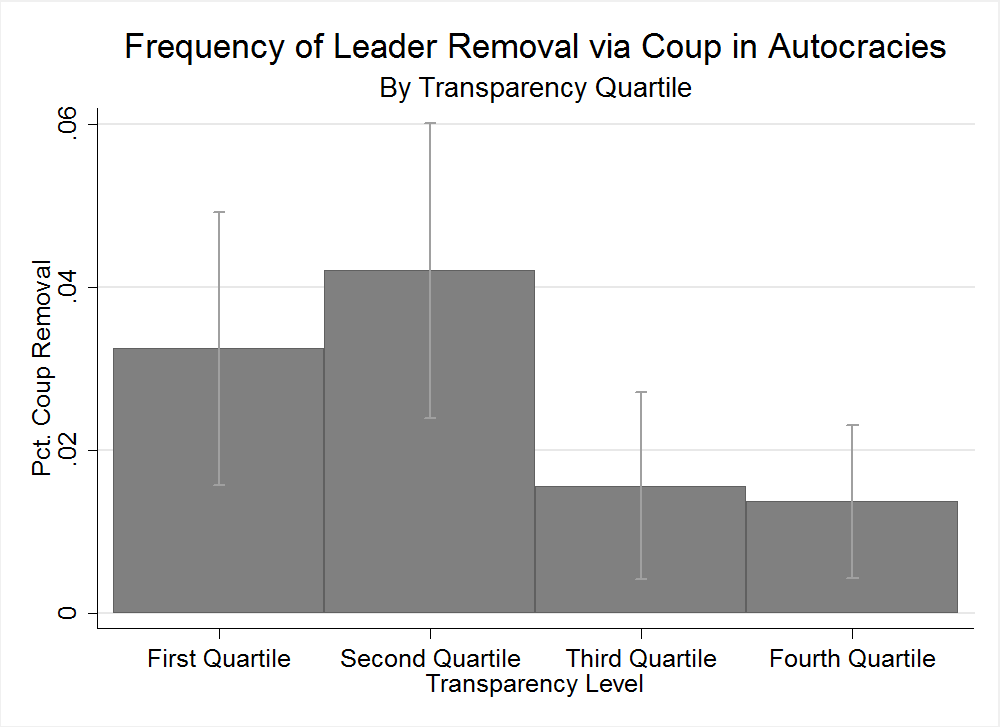
Massive protests in Kiev led to the flight of Ukraine President Viktor Yanukovych in 2014. Is transparency the solution to corrupt rule? (Photo by maksymenko oleksandr via flckr.)
Scenes of protesters confronting army tanks quickly claimed the world’s attention last month when Turkey’s military staged a coup attempt — and the ensuing crackdown has sparked worldwide concerns.
Ironically, Turkey’s President Recep Tayyip Erdogan, who had previously sought to strictly control social media, helped coordinate these protests through FaceTime and Twitter appeals, along with more traditional forms of communication. But with the spread of social media around the world, are coups more or less likely to occur?
While social media are sufficiently new, and coups sufficiently infrequent to assess this claim, there’s another way to look at the link between coups and access to information. In a series of papers and an ongoing book project, we examine the relationship between political instability and government disclosures of credible economic information — the type of information members of the public might use both to evaluate the performance of the government and to gauge the level of discontent of their fellows. We term such disclosures “government transparency.” (We recognize that transparency has other facets, and discuss these as well.)
We looked at how governments in 125 countries shared information.

Democracy (Via Flickr)
We were able to estimate how likely the governments of 125 countries were to disclose information, during the period from 1980 to 2010. Scores range from approximately -11 to 10, with higher scores depicting a greater tendency to disclose. We got there by measuring each government’s tendency to disclose credible economic data, using an algorithm to predict missing observations from economic data series published by international institutions and collected from national governments. In non-technical terms, we measured the economic information governments didn’t make public.
And we reached a simple conclusion: More information leads to fewer coups — in both democracies and non-democracies:
1) Democracies. The relationship between transparency and political stability in democracies is simple: More transparency means more stable democratic rule. As transparency rises, democratically elected leaders are less likely to be ousted through extra-constitutional methods like a coup, and democratic institutions are less likely to be overthrown and replaced with autocratic rule.
Figure 1 below depicts the frequency of irregular leader removal in democracies, at various levels of our measure of transparency. The height of the bar reflects the percentage of years that witness an irregular leader removal, of all democratic years with a given level of transparency in a sample that runs from 1980-2004 (the gray lines depict the uncertainty — i.e., 95 percent confidence intervals around these estimates). So, as transparency rises, the frequency of irregular leader removals falls. In the fourth quartile, where transparency scores are highest, there are no irregular changes in regime.

Figure 1. Irregular leader removals as a function of transparency. As governments become more transparent, they become less likely to see their leaders removed via coups or other extra-constitutional methods. Data: Archigos Data Set of Political Leaders. Figure: James R. Hollyer.
In part, this may be for the reasons suggested by observers of the recent Turkish coup: Citizens knew that the Erdogan government enjoys widespread popular support, and could gauge the willingness of their fellows to support the coup attempt. (By our measure, Turkey discloses large amounts of economic information.)
But access to information also affects the conduct and legitimacy of the electoral process itself. Where information is abundant, citizens can be confident that economically under-performing governments will be voted out of office, reducing the need to resort to irregular, extra-constitutional removals.
Moreover, when information is disclosed to the general public, citizens can be more confident that their fellow voters are acting in an informed manner. This implies that election outcomes would reflect legitimate differences in values or circumstances, rather than a situation in which a large share of the electorate is comprised of dupes or is being bribed by the powers that be. Hence, electoral results are legitimized. Even opponents of an elected government may be more willing to support it in the face of a coup as transparency rises, and will be less willing to resort to extra-constitutional means to challenge the leadership, knowing they will likely face a determined opposition.
2) Non-democracies. The relationship between transparency and political stability in non-democracies is more complicated. Greater transparency still means fewer coups. However, greater disclosure carries risks for the regime — there’s a greater threat of mass protest and transition to democracy. Indeed, we argue that there exists a natural trade-off between these two forms of threat.
Figure 2 below depicts the frequency with which autocratic leaders are ousted via coups, as a function of transparency. Again, the height of each bar reflects the proportion of years in which an autocratic leader is ousted via a coup, of all autocratic leader years, and the gray lines depict the uncertainty of these estimates. Autocracies with levels of transparency below the median experience substantially more coups than those with levels above the median, in the sample that runs from 1980-2007.

Figure 2. Autocratic leader removal via coup as a function of transparency. Transparency matters even in autocracies; those with substantially greater government transparency are less likely to see the government overthrown. Data: Milan Svolik, HRV Transparency Index. Figure: James R. Hollyer.
As in democracies, greater levels of transparency ensure that citizens can make more informed inferences about the behavior of an autocratic government. Importantly, they can also make more informed inferences about their fellow citizens’ perceptions of the government.
Since citizens in non-democracies do not have the ability to meaningfully express their preferences through the ballot box, to impose significant punishment on their leaders they must take to the streets. Protesting alone or in small groups, however, is incredibly risky in most autocracies. Typically protesters can only gain concessions from the government and ensure their own safety if they can be sure that large numbers will join them in the streets.
Under these conditions, government transparency plays an important role in facilitating protest because it allows citizens to better understand the extent of discontent with the government. In opaque settings, individuals are unlikely to be sufficiently sure that discontent is widely shared to engage in risky protests. Greater transparency is therefore associated with more frequent protests and the increased likelihood of transition to democracy.
Ironically, however, the role transparency plays in increasing the ability of the populace to mobilize may discourage coups. On the one hand, the populace may mobilize in support of the sitting leadership, and against coup plotters, as we witnessed in Turkey. On the other, would-be protesters may view the coup as a moment of regime weakness. They may mobilize not only to foil the putschists, but to oust the autocratic elite more generally. Here the salient example is the counter-coup that led to the dissolution of the Soviet Union in 1991.
In either case, transparency’s role in facilitating mobilization by the public inhibits would-be coup-plotters. Indeed, cunning autocratic leaders manipulate the informational environment to trade off one form of threat against the other.
Social media may fragment information channels.
While social media clearly differs from government transparency both in terms of the content of information and the channels through which it is disclosed, these results are at least broadly supportive of the hypothesis that social media may reduce the frequency of coup attempts.
One concern is the extent to which social media promotes fragmentation of information channels: Critical to our theories of transparency is the extent to which information is observed and known to be observed by broad swaths of citizens. Transparency is able to facilitate protest because it informs a broad cross-section of society of the extent of discontent — and citizens are aware that their fellows have access to this information. A highly fragmented social media environment — in which citizens only communicate within narrow groups defined by social identity, class, or ideology — may not play the same role.

By Burak Su – Gezi parkı
With regard to Turkey, our results are consistent with other political scientists who find the coup attempt both surprising and unlikely to have ever succeeded. While the current version of our measure of transparency does not run beyond 2010, and there is some evidence of a decline in Turkey’s government transparency score beginning in 2006, Turkey’s transparency score is quite high in recent years. Our estimates of Turkey’s transparency score over time are plotted below, where the vertical axis depicts transparency levels and the horizontal axis the year. The lines depict the uncertainty around these estimates.
Turkey’s earlier attempts to join the European Union, and the AKP’s roots in the small business community, might help to explain the Erdogan government’s willingness to disclose economic information. The downward trend starting in 2006 is consistent with views that Erdogan’s administration has been associated with the erosion of democracy — yet Turkey continues to disclose economic data at high rates.
This informational environment, coupled with Turkey’s relatively high level of economic development, typically would imply that democratic rule is quite secure. The spread of social media may have rendered the success of the coup less likely still, but — based on these characteristics — the coup plotters never faced great chances of success.

Figure 3. Turkish government transparency over time. The dots depict estimated values, while the lines depict levels of uncertainty around these values. Data: HRV Transparency Index. Figure: James R. Hollyer.
This article was originally published at Monkey Cage blog and is reprinted with permission of the authors.
James R. Hollyer is Benjamin Evans Lippincott Assistant Professor in Political Economy at the University of Minnesota. B. Peter Rosendorff is a professor of Politics at New York University. James Raymond Vreeland is a professor in the School of Foreign Service and the Government Department at Georgetown University.
